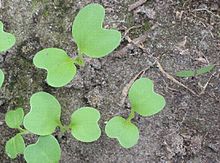Our website is made possible by displaying online advertisements to our visitors.
Please consider supporting us by disabling your ad blocker.
Eudicots
| Eudicots Temporal range:
| |
|---|---|

| |
| Two seed leaves during germination (Brassica sp.) | |
| Scientific classification | |
| Kingdom: | Plantae |
| Clade: | Streptophyta |
| Clade: | Embryophytes |
| Clade: | Polysporangiophytes |
| Clade: | Tracheophytes |
| Clade: | Spermatophytes |
| Clade: | Angiosperms |
| Clade: | Eudicots |
| Clades (APG IV) | |
| |

The eudicots or eudicotyledons are flowering plants that have two seed leaves (cotyledons) upon germination.[1] The term derives from dicotyledon (etymologically, eu = true; di = two; cotyledon = seed leaf). Historically, authors have used the terms tricolpates or non-magnoliid dicots. The current botanical terms were introduced in 1991, by evolutionary botanist James A. Doyle and paleobotanist Carol L. Hotton, to emphasize the later evolutionary divergence of tricolpate dicots from earlier, less specialized, dicots.[2]
Scores of familiar plants are eudicots, including many commonly cultivated and edible plants, numerous trees, tropicals and ornamentals. Among the most well-known eudicot genera are those of the sunflower (Helianthus), dandelion (Taraxacum), forget-me-not (Myosotis), cabbage (Brassica), apple (Malus), buttercup (Ranunculus), maple (Acer) and macadamia (Macadamia). Most leafy, mid-latitude trees are also classified as eudicots, with notable exceptions being the magnolias and American tulip tree (Liriodendron)—which belong to the magnoliids—and Ginkgo biloba, which is not an angiosperm.
- ^ "EUDICOTS". Basic Biology. Basic Biology 2020. Retrieved 6 July 2020.
- ^ Endress, Peter K. (2002). "Morphology and Angiosperm Systematics in the Molecular Era" (PDF). Botanical Review. Structural Botany in Systematics: A Symposium in Memory of William C. Dickison. 68 (4): 545–570. doi:10.1663/0006-8101(2002)068[0545:maasit]2.0.co;2. JSTOR 4354438. S2CID 39486751.
Previous Page Next Page


